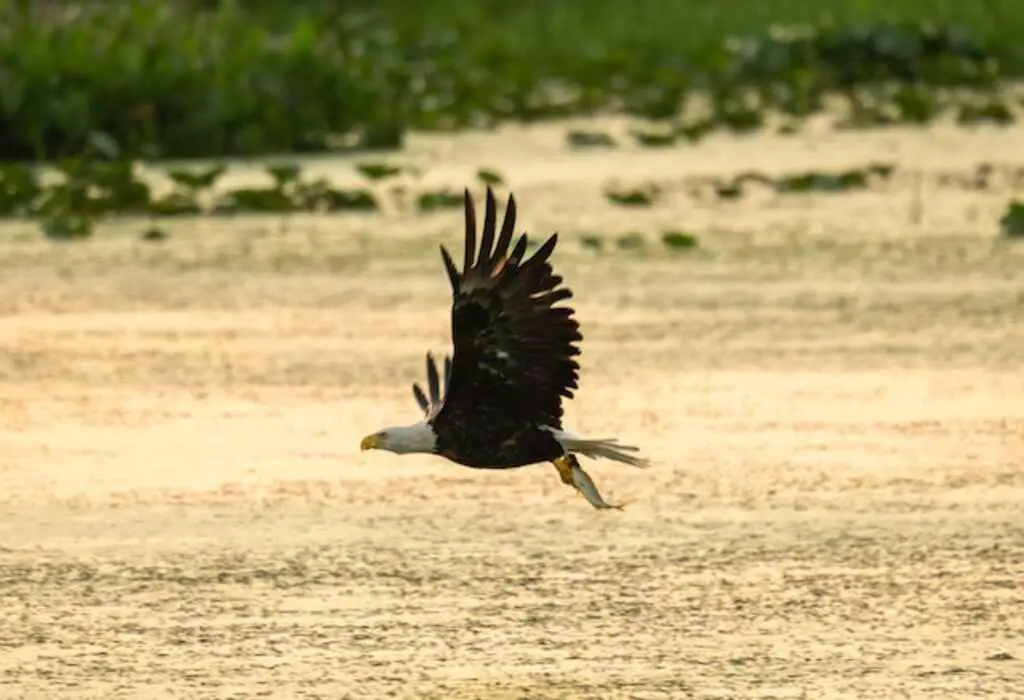Eagles are among the most majestic creatures in the animal kingdom. With their impressive wingspans, sharp talons, and keen eyesight, they are formidable predators that can take down prey much larger than themselves.
One of the most impressive feats that eagles are known for is their ability to catch fish from bodies of water. But how do eagles carry fish once they have caught it?
To answer this question, we must first understand the various techniques that eagles use to catch fish.
From there, we can explore the challenges that eagles face when it comes to carrying heavy prey, and the strategies they use to overcome those challenges.
Ultimately, we will gain a deeper appreciation for the remarkable abilities of these magnificent birds of prey.
Table of Contents
- 1 Key Takeaways
- 2 Overview of Eagle Fishing Techniques
- 3 How Do Eagles Carry Fish
- 4 The Challenge of Carrying Heavy Prey
- 5 Gripping with Talons
- 6 Adjusting Flight for Balance
- 7 Tucking the Fish Under One Wing
- 8 Using the Beak for Fshing Maneuver
- 9 Carrying the Fish to the Nest or Perch
- 10 Feeding on the Prey
- 11 The Importance of Fish in the Eagle’s Diet
- 12 Conservation Efforts for Eagles
- 13 Frequently Asked Questions
- 14 Conclusion
- 15 Author
Key Takeaways
- Eagles are skilled hunters that use their keen eyesight to locate prey near water bodies.
- They have developed several adaptations such as sharp talons and adjustments in flight patterns to carry heavy fish, which can weigh up to half of their body weight.
- Eagles use their beak to maintain control and maneuverability during flight while carrying prey.
- Ingested fish are broken down in the eagle’s digestive system through stomach acid and digestive enzymes.
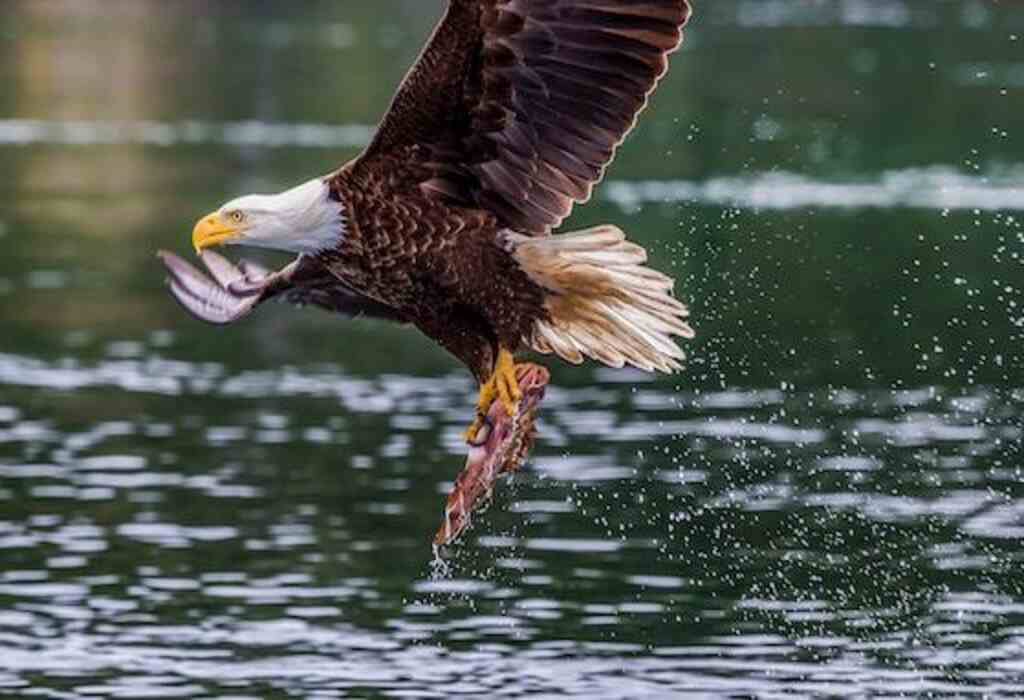
Overview of Eagle Fishing Techniques
The present discourse aims to provide an overview of the various fishing techniques employed by eagles, which includes their hunting strategies, selection of prey, and methods of carrying fish.
Eagles are known to be skilled hunters that exhibit a range of fishing habits. They typically hunt near water bodies and use their keen eyesight to locate prey.
Once they spot a fish, they swoop down and snatch it from the surface of the water with their powerful talons. Eagles also use their beak to grab fish that are swimming beneath the surface.
After catching their prey, eagles employ different methods of carrying fish. Some eagles use their talons to carry the fish, while others use their beaks.
The choice of method depends on the size and weight of the fish. The challenge of carrying heavy prey is a significant hurdle that eagles must overcome, and we will explore this in the subsequent section.
How Do Eagles Carry Fish
Eagles carry fish using their powerful talons, which lock onto the slippery prey. Their curved beaks aid in gripping and maneuvering the catch. This allows them to effortlessly transport fish through the air, showcasing their impressive hunting skills and adaptability.
The Challenge of Carrying Heavy Prey
Transporting hefty prey presents a taxing task for raptors. Eagles, being one of the largest birds of prey, face the challenge of carrying heavy fish that can weigh up to half of their body weight.
This feat requires them to adapt and develop unique strategies to overcome the difficulties of carrying their catch.
The challenges include maintaining balance, aerodynamic drag, and avoiding injury to their wings.
To overcome these obstacles, eagles have developed several adaptations, such as growing stronger muscles and bones to support their weight, having large wings to increase lift, and using their tail feathers to stabilize their body during flight.
Additionally, eagles use their beaks to hold onto the fish while adjusting their grip to alleviate any discomfort or potential injury.
These adaptations allow eagles to successfully carry their prey to their nest or feeding ground.
Gripping with talons is the next step in the process of eagle fishing.
Gripping with Talons
When capturing their prey, raptors use their sharp talons to immobilize and secure their target.
This allows them to grasp onto prey with incredible strength and not let go. When carrying a fish, eagles will use their talons to grip onto the fish and lock them in place.
The weight of the fish can be a challenge, but eagles are able to adjust their grip and shift the weight as needed to maintain balance during flight.
It is fascinating to watch these majestic birds in action, as they effortlessly glide through the air with their prey in tow.
Here’s a table illustrating the gripping power of an eagle’s talons compared to a human handshake:
| Eagle’s Talons | Human Handshake | |
|---|---|---|
| Pressure | High | Moderate |
| Force | Strong | Average |
| Grip Strength | Powerful | Firm |
| Adaptability | Versatile | Limited |
| Precision | Exceptional | Moderate |
Please note that the values provided in the table are for illustrative purposes only and may vary depending on the specific circumstances and individuals involved.
Moving on to the next section, ‘adjusting flight for balance’, eagles must use their wings and body positioning to maintain equilibrium while carrying their heavy load.
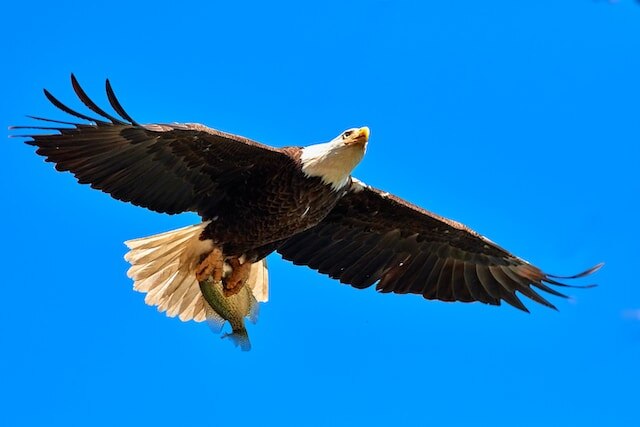
Adjusting Flight for Balance
To maintain balance and stability while carrying heavy prey, eagles must make constant adjustments to their flight patterns and body positioning.
This includes adjusting their altitude and wing positioning to compensate for the weight of the fish.
Eagles will often fly with one wing slightly lower than the other to create an uneven balance, which allows them to adjust their flight and remain airborne for longer periods.
Additionally, they will use their tail feathers to steer and control their movements, making small adjustments to their trajectory as they fly.
By constantly adapting their flight patterns, eagles are able to carry heavy prey for long distances without losing momentum or becoming fatigued.
This level of adaptability is a testament to their strength, agility, and freedom in the wild.
As eagles approach their destination, they will often tuck the fish under one wing to prepare for landing, which we will explore in the next section.
Tucking the Fish Under One Wing
As the eagle nears its destination, it gracefully tucks its prized catch snugly beneath one of its powerful wings, readying itself for a seamless landing.
The position of the wing plays a crucial role in ensuring that the eagle maintains balance during flight.
The wing on the side opposite the fish is extended to create lift, while the one with the fish is tucked in close to the body to reduce drag.
This positioning allows the eagle to maintain maximum aerodynamic efficiency while carrying its prey.
Additionally, the eagle may adjust the angle of its wings to compensate for wind and other external factors that could affect its flight.
By using its keen sense of aerodynamics, the eagle is able to ensure a smooth and effortless journey to its destination. In the next section, we will explore how the eagle uses its beak to maneuver during flight.
Using the Beak for Fshing Maneuver
The eagle’s beak serves as a crucial tool. For instance, when it comes to fishing maneuvers, the eagle uses its beak to accurately snatch fish from the water’s surface.
The sharp, curved tip of the beak acts as a grappling hook, enabling the bird to catch and hold onto prey with ease.
Additionally, the beak’s serrated edges provide the necessary grip to prevent the fish from slipping out of the eagle’s grasp.
To maintain control while flying, the eagle instinctively adjusts the angle of its beak, allowing it to adapt to changes in wind speed and direction.
This beak control is critical during flight, especially when carrying a heavy load such as a fish.
The eagle’s beak is a testament to the intricacies of nature and the evolutionary adaptations that allow animals to thrive in their respective environments.
With the fish securely in its beak, the eagle will typically head towards its nest or perch, where it will enjoy its well-earned meal.
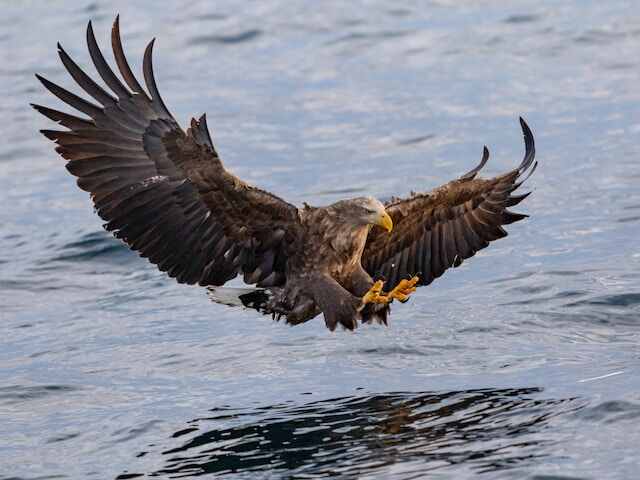
Carrying the Fish to the Nest or Perch
Once the eagle has successfully caught its prey, it will typically soar towards its nest or perch, where it can consume its meal in a safe and secure environment.
Carrying the fish to the nest or perch requires skillful coordination and balance on the part of the eagle.
Eagles have evolved with an incredible set of hunting strategies that enable them to hunt and capture prey effectively.
Their hunting strategies include diving, swooping, and snatching prey from the water’s surface. Once the fish is captured, the eagle will use its sharp talons to firmly grasp the fish.
The eagle will then adjust the fish’s position so that it faces headfirst, reducing drag and making it easier to carry.
Eagles have also been observed using their beaks to adjust the fish’s position while in flight, making small adjustments to maintain balance and maintain control over the prey.
Nest construction plays a vital role in the eagle’s feeding process, as it provides a secure environment where the eagle can consume its meal without fear of predators or other threats.
The eagle will often tear the fish apart using its sharp beak, consuming the flesh and discarding the bones.
Understanding how eagles carry fish is essential to understanding the complex hunting and feeding strategies of these remarkable birds of prey.
Feeding on the Prey
After successfully carrying the fish to the nest or perch, the eagle then proceeds to feed on its prey.
Eagles have unique feeding techniques that allow them to consume their prey efficiently. They use their sharp beaks to tear apart the flesh and extract the meat, which they swallow whole.
Ingested fish are then broken down in the bird’s digestive system, where the stomach acid and digestive enzymes break down the proteins, fats, and other nutrients.
This digestion process is crucial to the eagle’s survival, as it allows them to extract the necessary nutrients from their food.
Understanding the feeding and digestion process of eagles is essential to appreciate how these majestic creatures have adapted to survive in their natural habitat.
The importance of fish in the eagle’s diet cannot be overstated, and this will be explored further in the subsequent section.
The Importance of Fish in the Eagle’s Diet
Fish act as a vital foundation of the eagle’s diet, serving as a keystone species in their ecosystem and providing a crucial link in the food chain, much like the foundation of a building.
For eagles, fish are a primary source of protein and essential nutrients, helping them maintain their strength and agility.
However, the role of fish farms in the supply of prey to eagles is controversial, with some arguing that they provide a vital source of food while others claim that they may negatively impact wild fish populations.
Additionally, pollution in aquatic environments can also harm fish populations, affecting the eagles that rely on them.
As a result, conservation efforts are crucial to ensure that eagles have access to healthy fish populations for their survival.
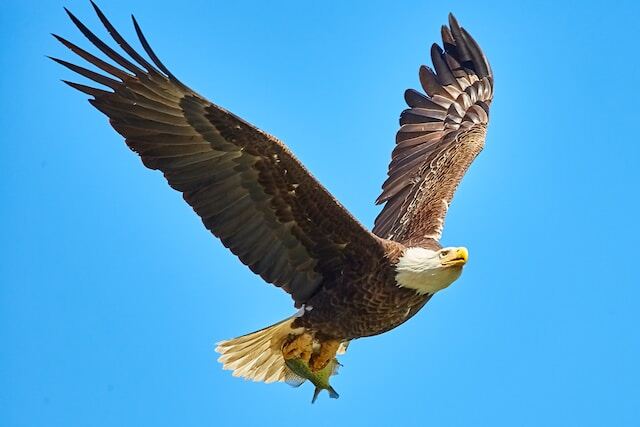
Conservation Efforts for Eagles
Conservation efforts for eagles include habitat protection, reduction of human disturbance, and monitoring of populations to ensure their survival and recovery.
Habitat protection is crucial for eagle conservation, as eagles require large territories to hunt and nest. This includes protecting nesting sites from disturbance, such as logging or development.
Reduction of human disturbance involves minimizing human activities that may disrupt eagle behavior, such as recreational activities or construction.
Monitoring eagle populations is important to track population trends and identify potential threats to their survival. This information can be used to inform management decisions and adjust conservation strategies as needed.
Overall, conservation efforts for eagles play a critical role in ensuring the long-term survival and recovery of these majestic birds.
Frequently Asked Questions
How do eagles know where to find fish?
Exploring fish location and eagle vision reveals how eagles detect prey. Investigating fish behavior and eagle hunting strategies uncovers variations in hunting methods. This knowledge enhances understanding of eagle behavior in the wild.
How long can eagles carry fish before they need to eat it?
How long eagles can carry fish before eating it depends on fish preservation and nutritional value. Environmental factors and migration patterns can impact their fish storage capacity. Understanding these behaviors is crucial for conservation efforts and maintaining the ecosystem.
Do all eagles use the same fishing techniques?
Eagle fishing techniques vary based on the size and weight of the fish. Some eagles use a swooping technique to catch fish in mid-air, while others dive straight into the water. Their carrying ability depends on their strength and size.
How do eagles protect their catch from other predators?
Predator prey dynamics play a significant role in how eagles protect their catch from other predators. Eagles use various hunting strategies, such as swooping in from above or using their talons to snatch prey, to secure their catch and fend off any potential threats.
Are there any risks for eagles when carrying heavy fish?
Eagles face risks when carrying heavy fish due to the impact on their flying techniques. The size of the fish can affect their balance, speed, and agility, making them vulnerable to predators. Technical analysis is necessary to understand the intricacies of this process.

Conclusion
In conclusion, eagles use a variety of fishing techniques to catch their prey, including swooping down from above or diving into the water.
However, the challenge arises when it comes to carrying the heavy prey back to their nest or perch. Eagles grip the fish tightly with their talons and adjust their flight to maintain balance.
They often tuck the fish under one wing, using their other wing to help steer and control their flight.
Once safely back at their nest or perch, eagles feast on their catch, which is an essential part of their diet. Fish provide the necessary nutrients and protein that eagles need to survive and thrive.
Unfortunately, due to pollution and overfishing, some species of fish have become scarce, putting the eagle’s food source at risk.
Conservation efforts, such as protecting fish habitats and regulating fishing practices, are crucial to ensuring the survival of not only the fish but also the majestic eagle.
For example, a recent study found that the bald eagle population in the Pacific Northwest was declining due to the decline in salmon populations.
Researchers discovered that eagles were not getting enough food to sustain themselves and were forced to scavenge for other sources.
However, after implementing measures to protect and restore salmon habitats, the bald eagle population began to recover.
This highlights the importance of conservation efforts in preserving not just one species, but the entire ecosystem.

